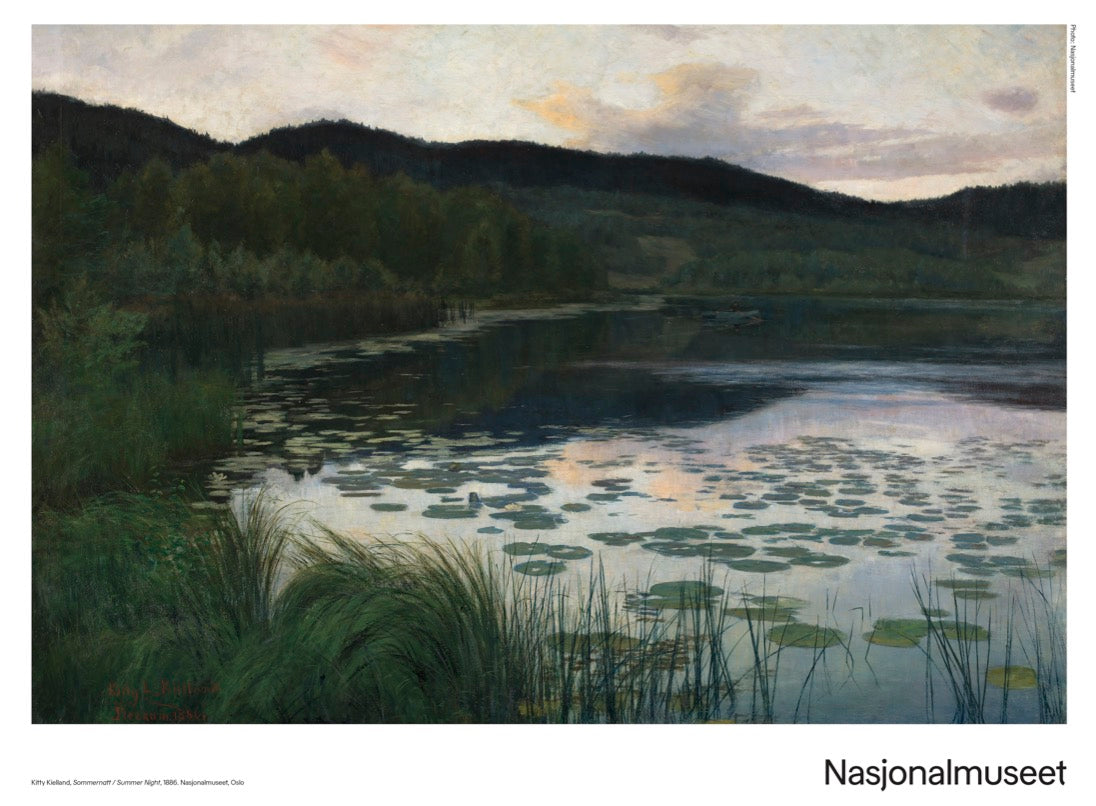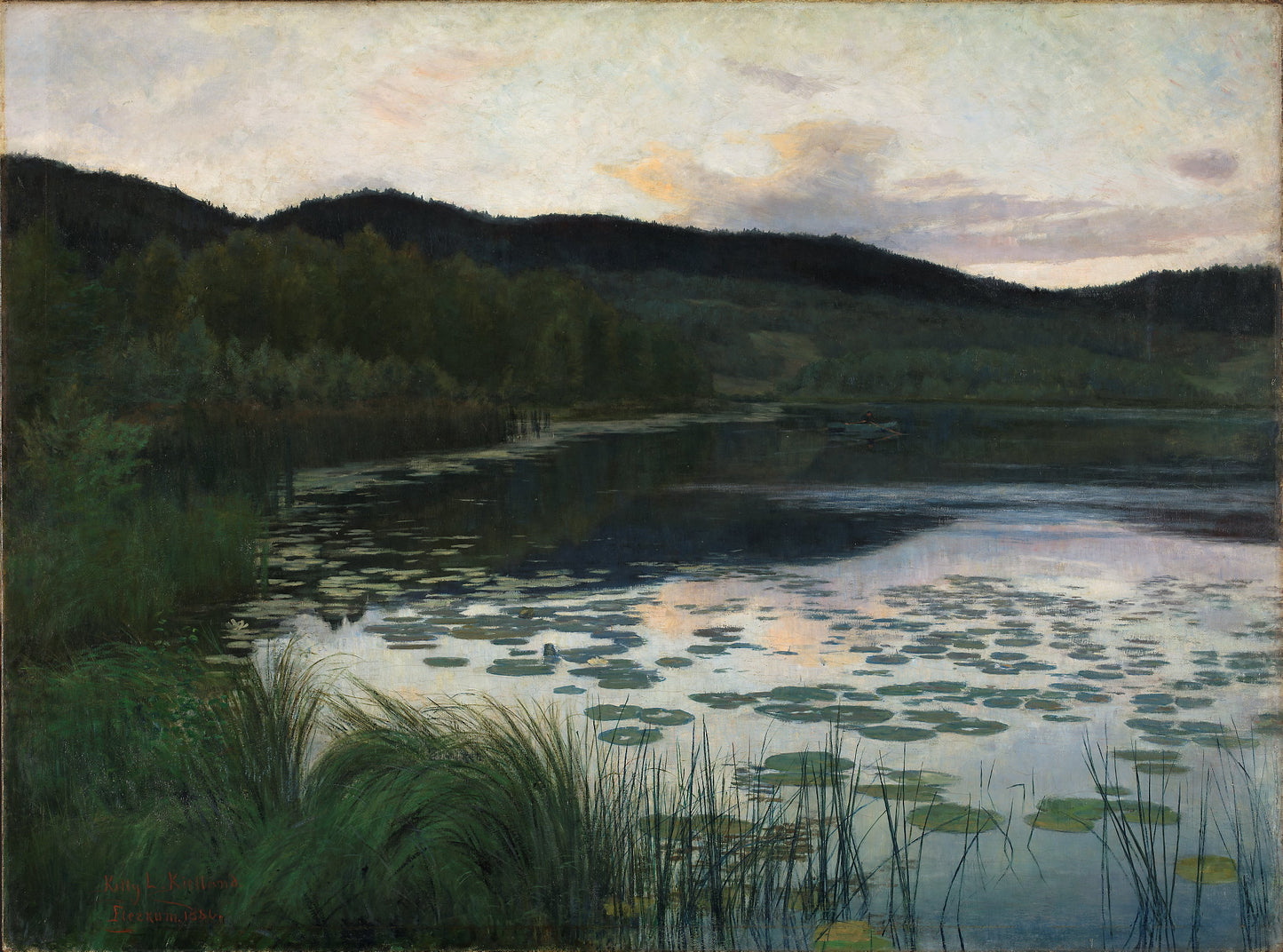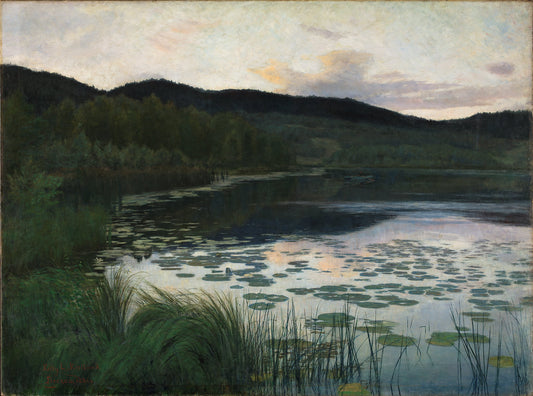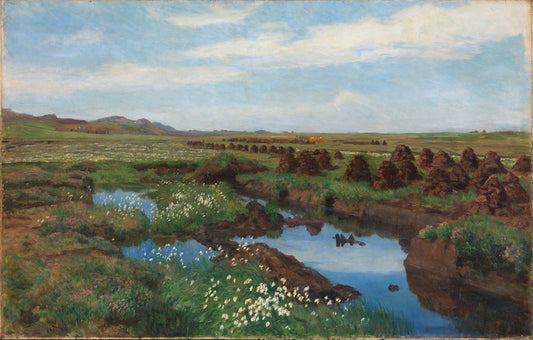Kitty Kielland
Summer night
Summer night
Couldn't load pickup availability
High-quality reproductions from the National Museum's collection. Posters by DAIDDA are printed on Litho White Matt - 230 gram photo paper in premium quality. Artprints by DAIDDA are printed on Moab Entrada Natural 190 gram cotton art paper in premium quality. Produced by DAIDDA.
About the original:
A quiet lake is surrounded by dark wooded hills. It is dusk and the sun is about to disappear on the horizon. Its faint reflection is felt on the surface of the water, along with the reflection of the sky's mother-of-pearl shimmer, clouds and hills. Far away, lying in semi-darkness, a small boat with a person rowing towards the horizon can be seen. Close up towards us, in the foreground of the picture, are green slender reeds. They are as motionless in the windy night as the tender water lilies scattered over the sea, like stars in the sky.
The painting depicts the magical twilight characteristic of a Nordic summer night in the forest. The very calm and atmosphere of the image suggests a sense of the timeless and unchanging, which draws the mind to the eternal and enigmatic laws of nature. The connection to natural mysticism is reinforced by the mysterious obscuring of the surroundings by darkness. At the same time, the mystery is emphasized by the fact that sky and earth seem interwoven with each other, through the mirror reflections on the water's surface.
Kitty Kielland got inspiration for the motif from Dælivannet in Bærum. Together with several artist colleagues, she spent the summer of 1886 at Fleskum farm. "Fleskumsommeren" is often said to usher in neo-romanticism in Norwegian art, and Kielland worked within this style until the 1890s.
Text: Nina Denney Ness
Date: 1886
Other titles: Summer Night (ENG)
Designation: Painting
Material and technique: oil on canvas
Technique: Oil
Material: Canvas
Dimensions: H 100.5 cm x W 135.5 cm x D 2.5 cm
Subject: Visual arts
Classification: 532 - Visual arts
Type of motif: Landscape
Acquisition: Bought by the artist in 1890
Inventory no.: NG.M.00357
Part of exhibition: Art 3. Works from the collection 1814-1950, 2007 - 2011
The dance of life. The collection from antiquity to 1950, 2011 - 2019
Luz del Norte / Llum del nord, 1995
Edvard Munch. The sick child. The Story of a Masterpiece, 2009
Im Lichte des Nordens. Scandinavian Painting at the Turn of the Century, 1986 - 1987
Dreams of a summer night. Scandinavian painting at the turn of the century, 1986
Luz del Norte / Llum del nord, 1995
Landschaft als Kosmos der Soule. Malerei des nordischen Symbolismus bis Munch, 1998
Nordic moods. Nordic painting at the turn of the century, 1987
Registration level: Single object
Owner and collection: The National Museum of Art, Architecture and Design, Visual Art Collections
Shipping and returns
Shipping and returns
Shipping: We deliver to Scandinavia, the EU, the USA and several other countries. Please contact us if your country is not listed and we will try to arrange delivery.
Delivery time: 2-5 days within Norway, 7 days in Europe, 14 days globally.
Packaging: Our products are made to order and sent rolled in environmentally friendly packaging.
Customs Fees: International orders may be subject to customs fees, which are not included in shipping costs.
Return policy: You can return images within 14 days. See our returns page for more information.
Secure Payment: We never store your payment details. See our privacy policy for details.


See all works
-
Summer night
Vendor:Kitty KiellandRegular price From 150,00 NOKRegular priceUnit price per -
Peat bog on Jæren
Vendor:Kitty KiellandRegular price From 150,00 NOKRegular priceUnit price per -
Arne Garborg in the painter's studio in Paris
Vendor:Kitty KiellandRegular price From 150,00 NOKRegular priceUnit price per -
 Sold out
Sold outSummer night
Vendor:Kitty KiellandRegular price 2.500,00 NOKRegular priceUnit price per3.400,00 NOKSale price 2.500,00 NOKSold out

Kitty Kielland
Kitty Lange Kielland was a Norwegian landscape painter. She was a naturalist painter and was concerned that art should portray life and truth. Kielland was the first to paint the peculiar beauty of the Jærlandscape; in the areas around Ogna and Time, she depicted the coastal country's sandy stretches and desolate marshes.
A fine example is Torvmyr from 1880 - a picture that shows her interest in atmosphere and atmosphere in her landscape depictions. She also pioneered the lyrically emphasized mood painting of the 1880s, with summer evening motifs such as After Sunset (1885, Slottet i Oslo) and Summer Night (1886, National Museum/National Gallery in Oslo). She has also painted some still lifes and interiors. Alongside her artistic practice, she was also a committed writer who authored several articles on art. In 1884, she helped to found the Norwegian Women's Association, and she wrote many debate articles in newspapers and magazines that raised questions about women's emancipation. Apprenticeship Kitty Kielland was born and raised in Stavanger. She was the sister of the author Alexander Kielland and took an early interest in drawing and painting. She met the painter Hans Gude when he visited his family in Stavanger in 1872, and the following year she became his pupil in Karlsruhe.
As a woman, she did not have access to the academy and instead received private lessons from Gude. Her landscape pictures from this time are clearly inspired by Gude, with a foreground with detailed plants and often kept in a brownish tone. A fine example is the study Morning in Bjerkreim from 1874, with a young shepherd sitting on a stone fence and silhouetted against the bright sky behind. In 1875 she left Karlsruhe in favor of Munich, which now established itself as the new art center for the Norwegian art students in Germany. The painters Harriet Backer, Asta Nørregaard, Benedicte Scheel, Hans Heyerdahl, Erik Werenskiold, Gerhard Munthe, Christian Skredsvig and Theodor Kittelsen also came here. Kielland shared accommodation with Harriet Backer, and the two young women had to take private lessons also in Munich, as the academy was reserved for men. Kielland was proofread by Eilif Peterssen and by the German landscape and animal painter Hermann Baisch. She often spent the summers in Norway, and as early as 1876 she drew and painted studies on Jæren. They resulted in her first Jærlandskap, Landscape from Jæren from 1877, painted the following winter in Munich. Inspired by French plein air painting, Kielland traveled to Paris in the spring of 1879. She also lived here with her friend Harriet Backer. In 1880, Kielland became a pupil of the landscape painter Léon Germain Pelouse, after having seen his open-air pictures at the Salon the year before. Influenced by his way of portraying landscapes, Kielland changed his own painterly style. She now painted in short, pasty strokes, with clear colours. The result is images where the surface vibrates with life. A fine example is Flowering Tree in Cernay-la-Ville from 1880. In the summer of 1881, she painted together with Pelouse in Brittany, a stay that became important for her development as a plein air painter. In Paris, Kielland practiced his drawing skills by drawing from models at the Académie Julian and at the Académie Colarossi. She was Pelouse's pupil until the mid-1880s. Then her apprenticeship was over. Together with Harriet Backer, she lived in Paris until 1889, when she returned home to Kristiania (Oslo). Jæren's painting Zoom inTorvmyr Torvmyr from 1880 with motif from Jæren Torvmyr By Kitty Kielland. Licence: Limited reuse Jæren, and the peat bogs there, was the motif Kielland kept coming back to. She drew and painted studies at Jæren from 1874, and her artistic breakthrough came with pictures from here. In the summer of 1878, she had painted studies at Ogna on Jæren, and two of these she had processed into paintings which the following year were accepted at the Salon in Paris. The following year she also commissioned two pictures, including the magnificent Torvmyr from 1880, where she lets the sky fill two-thirds of the picture surface on the square canvas. In the dark foreground we can make out stacks of peat, peat left to dry so that it can later be used for fuel. The dark cumulus clouds, with sunlight barely breaking through the cloud layer in the background, create a grand and melancholic mood. The oil study Torvmyr (1882, National Museum) and the painting Torvmyr (1883, private property) show the influence of Pelouse, with brighter colors in dense strokes. Both images are given in height format, which means that the high sky with the rain-heavy clouds towers powerfully over the peat bogs on Jæren. Kielland probably got this impression of the high sky towering over a narrower strip of landscape from Dutch landscape painting from the 17th century.
Kielland's later peat bog pictures tend to be lighter in tone, with extensive use of water mirrors. Torvmyr (1897, KODE art museums in Bergen) has clear blue and green colours, as the water reflects the bright blue sky. The melancholy of the early pictures has given way to pictures with a brighter and clearer colour. In the bog pictures from after 1900, the brushstrokes have become wider, more painterly or sketchy. The light is usually evenly distributed in the landscape, without large contrasts between light and dark. In this even light, the colors of the landscape stand out lusciously, clearly outlined against the soft sky. The mood painting Kielland spent the summer of 1885 in Risør, together with Harriet Backer. Here she painted a picture of the manor Bosvik, a summer evening picture where the house is reflected in the clear water in the foreground. The evening light collects the shapes in larger, more monotonous areas, and the water mirror captures the sky, which is still bright. The picture was named After Sunset and was exhibited at the Autumn Exhibition in 1885. After Sunset is considered to be the beginning of the neo-romanticism in Norway, where the painters sought to capture the special light of the Nordic summer night. In the summer of 1886, Kielland painted summer night motifs on the farm Fleskum in Bærum, where Christian Skredsvig lived. Erik Werenskiold, Gerhard Munthe, Eilif Peterssen and Harriet Backer also painted here this summer. The pictures that were painted here this summer mark the influence of neo-romanticism in Norwegian painting. The details disappear in the summer night light, and a melancholic mood spreads over the pictures. The main works from the summer are Peterssen's Summer Night, Skredsvig's Boy with the Willow Flute and Kielland's Summer Night. Again, it is the water mirror that interests Kielland, where the sky is reflected in the mirror-like water. Both After Sunset and Summer Night were exhibited at the World's Fair in Paris in 1889. In the same year she moved to Sandvika and also painted many atmospheric pictures from the Sandvik River. The following year she painted another summer night picture, this time from Western Norway. Evening landscape - Stokkavannet from 1890 is one of her best summer night pictures.






